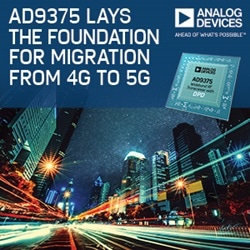Analog Devices, Inc. (ADI) today announced the latest update to its award-winning RadioVerse™ technology and design ecosystem, which simplifies and accelerates radio development for wireless carriers and telecommunications equipment manufacturers as they transition their cellular base stations from 4G to 5G networks.

ADI’s expanded RadioVerse portfolio features new radio transceiver hardware, software tools, and a robust design environment that enables the smaller, lower power radios necessary in next generation networks. The new offering allows customers to quickly evaluate and develop radio designs for 4G small cell and Pre-5G massive MIMO systems, key building blocks in the transition to 5G, enabling faster data rates while improving connectivity and data throughput in densely populated, high-traffic areas such as office buildings, sport stadiums and public transit systems.
Addressing radio design at the circuit, architecture, system and software levels, the updated RadioVerse release includes the AD9375 RF transceiver, the newest addition to ADI’s highly integrated wideband RF transceiver series. The AD9375 is the first RF transceiver to incorporate the digital pre-distortion (DPD) algorithm on-chip – a design breakthrough that reduces DPD power consumption by 90 percent compared to competing solutions.
The re-partitioning of the DPD system from the FPGA to the transceiver cuts the number of JESD204B serial data interface lanes in half, resulting in a dramatic power savings particularly as the number of antennas per base station increases from two to 128 in support of Pre-5G massive MIMO radio-channel density requirements. Other benefits include a more compact radio circuit layout, which simplifies routing and system design, reduces base station size, and allows designers to use a lower-cost, less complex FGPA. In small cells these benefits allow more frequency bands per cell for increased network capacity, while minimizing the impact to system power consumption and size.
The AD9375 transceiver enables a common radio platform design that is tunable over a range of 300 MHz to 6 GHz, operates on a 6-Gbps JESD204B interface and consumes less than 5 Watts. Similar to the award-winning AD9371, the AD9375 has two 100-MHz receivers, two 250-MHz transmitters, a two-input observation receiver and a three-input sniffer receiver. The transceiver’s integrated DPD solution supports 3G and 4G waveforms with an instantaneous signal bandwidth of up to 40 MHz.
In addition to the AD9375, the RadioVerse transceiver hardware portfolio features wideband devices for base station architectures ranging from macro- to pico- and femto-cell form factors, in addition to ultra-low power, narrowband transceivers for industrial Internet of Things applications that require long range, network robustness, and long battery life.
RadioVerse Design and Technology Ecosystem Accelerates Wireless Development
Developed to help customers reduce radio size, weight and power (SWaP) while maintaining the highest possible radio performance, the RadioVerse technology and design ecosystem includes a new small-cell radio reference design with a full AD9375-enabled JESD204B-to-antenna radio signal chain. This helps customers further simplify design and accelerate time to market, while minimizing engineering costs. Developed in partnership with Benetel Ltd., a radio solutions provider, the reference design supports 2x2 20-MHz LTE with 250-mW output-power-per-antenna and consumes less than 10 Watts, all in a small form factor measuring 88 mm x 83 mm.
ADI’s RadioVerse prototyping platforms also provide advanced simulation and analysis of the transceiver using MATLAB® and Simulink® modeling software, device drivers and full evaluation systems that directly connect to FPGA development platforms, and third-party hardware for moving quickly from concept to market. The design environment accelerates customer time-to-market through access to ADI’s EngineerZone® online technical support community, which hosts customer support forums, quick-start videos, technical articles, webcasts and product highlights.
Analog Devices will continue to expand its RadioVerse design environment through partnerships with leading power amplifier (PA) suppliers, including NXP Semiconductors N.V., and Skyworks Solutions, Inc., providing customers with test reports for AD9375 DPD with PA products of various output power and frequencies. Visit the RadioVerse alliance network site which has rapidly expanded to 20 companies in the past 12 months, including seven new reference designs targeting drone, wireless surveillance and software-defined radio markets.
Pricing and Availability
| Part Number |
Sample Availability |
Production Availability |
Price Each in 1,000 Units |
Package |
| AD9375BBCZ |
Now |
Now |
$325 |
12 x 12 BGA |
| ADRV9375-N/PCBZ |
Now |
Now |
$1450 |
AD9375 Evaluation Kit |
| ADRV-DPD1/PCBZ |
Now |
Now |
$2995 |
AD9375 Small Cell Radio Reference Design |